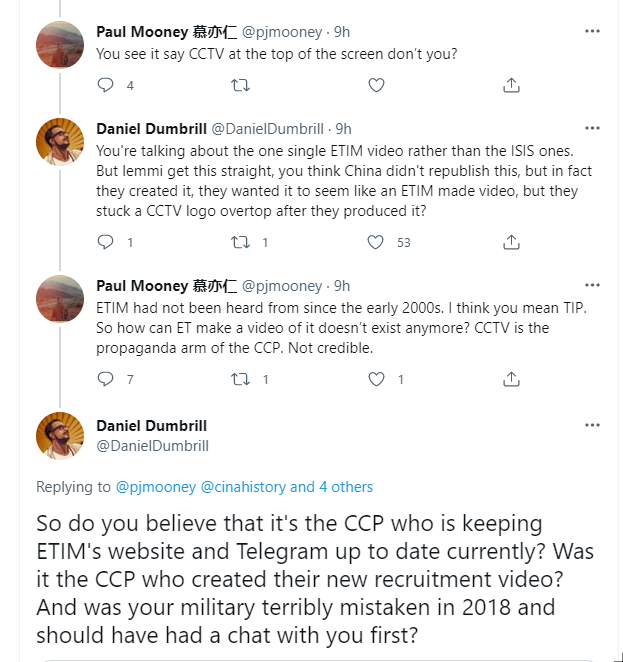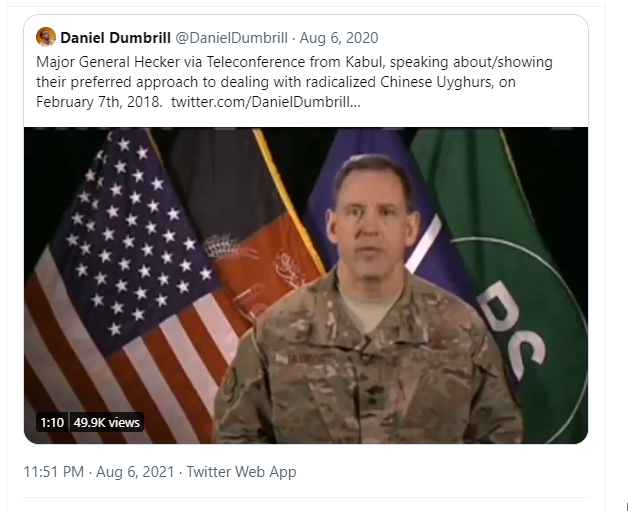In part 2 of this series, I demonstrated how ABC journalist Beverley O’Connor led Adam Turan through an anti-China narrative, demonstrating no inclination to challenge that narrative. In fact, she ‘led the witness’, posing questions such as “So in your mind this is ethnic cleansing?”
Determining exactly what drives the anti-China culture of the ABC is not simple, but analysing the outcomes in terms of reporting is straight forward. Therefore, the ABC’s complete lack of self-awareness is puzzling (but not surprising).
In this part I examine, in parallel, an analysis of some recent stories which give a clear picture of the blatant framing of China in negative terms.
Don’t talk about the war, except when it’s China
We begin with two stories from fairly recently, where authorities have moved against large tech companies to try to rein in their power and influence. The stories are:
China’s crackdown on ‘powerful’ tech giants may be a ‘terrible own goal’
and
The negative theme of the China story is there, right off the bat. China has stupidly shot itself in the foot. On the other hand, our saviour, the ACCC is keeping us safe from those giants who wish to tread all over us.
Let’s look to how the language generates the negative perspective on China. Here’s a breakdown of the negative language in the article (yes, there is positive language as well, but for the sake of brevity and contrast, we will look first at negatives)
Frequent words
| regulation / regulatory / regulator | 10 | crackdown | 8 |
| competition / competitive | 7 | risk | 7 |
| power | 4 | complacent | 3 |
| impose | 3 | anti-competitive | 2 |
| banned / banning | 2 | CCP | 2 |
| control | 2 | crack | 2 |
| fire | 2 | penalised / penalty | 2 |
| plunged | 2 | rival | 2 |
| tank | 2 | warned | 2 |
Note the language of oppression in purple. Remember, the topic here is a state that is exercising its right to regulate the practice of tech giants. Note that the topic itself attracts a relatively high 7 instances, as might be expected.
I wonder, when we turn to the ACCC story, whether this kind of language will be apparent. Well, no.
| pay | 7 | journalism | 5 |
| power | 5 | competition / competitors | 4 |
| free | 4 | force | 3 |
| push | 3 | threat | 3 |
| argue | 2 | critics | 2 |
| endanger | 2 | protectionism | 2 |
Here we have some evocative language, but little reference to oppression. Instead we have “concerns”, “unreasonable” or “one-sided”. “Regulate” (and its derivatives) goes from 10 instances (China story) to one. Conflict is “argue” or “threat”.
Less frequent words
Try picking which of these is about China?
| wiped, worse, accused, activists, addictive, advantage, alleged, allowed, alternative, attack, battle, blistering, blocked, casualty, caught, causing, collapse, compliance / comply, controversial, copped / copping, debacle, delay, dissenting, eliminating, enemy, exposure, forced, foreign, illegally, implement, inequality, infuriated, litigious, meltdown, mistake, monopolistic, oligarch, punished, pushed, retribution, shock, shot, submissive, surged, surrender, suspected, suspended, takeover, tensions, terrible, unpredictability | warn, absurd, compensation, concerns, confront, defender, demands, disrupt, dominance, fires, floodgates, idiocy, mandatory, misuse, one-sided, regulation, strike, unreasonable, watchdog |
One person’s free expression is another’s aggression
To be sure, this is an isolated instance. Really? Let’s look at another set of stories, about controversial Chinese artists.
| Australian artist Badiucao’s exhibition finally shown in Melbourne after China ‘threat’ ordeal – ABC News | Chinese artist behind doctored image of Australian soldier says he’s ready to make more – ABC News |
| https://www.abc.net.au/news/2020-02-27/badiucao-new-melbourne-exhibition-street-art-festival/11995456 | https://www.abc.net.au/news/2020-12-01/doctored-image-of-australian-soldier-tweeted-by-chinese-diplomat/12938244 |
| In 2019, Badiucao was awarded the Robert Russell Courage in Cartooning Award by the Cartoonists Rights Network International. | The Chinese artist behind a doctored image of an Australian soldier holding a knife to the throat of an Afghan child has taunted the Australian Prime Minister, saying that he would make another artwork in response to being “scolded”. |
| This month, the art of Chinese dissident Badiucao has finally seen the light of day in Melbourne — more than a year after the Australian artist’s Hong Kong exhibition was cancelled due to threats reportedly made by Chinese authorities. | Prime Minister Scott Morrison labelled the post “repugnant“, demanding it be removed and Beijing issue an apology. |
| Originally titled Gongle, the exhibition was supposed to be the kick-off event for Freedom of Expression Week in 2018, organised by the Hong Kong Free Press (HKFP), Amnesty International and Reporters Without Borders. | The image — created to criticise Australia over the damning Brereton war crimes inquiry — was posted on Twitter by China’s Foreign Ministry spokesman Zhao Lijian on Monday. |
| Now retitled Made in Hong Kong, Banned in China, the exhibition features 19 works and sits at the entrance of The Facility in Kensington, where 150 street artists have taken over the three-storey, red brick warehouse and a 22-wagon freight train as part of Melbourne’s inaugural 10-day urban art festival Can’t Do Tomorrow. | Mr Fu’s artwork has echoed China’s aggressive diplomacy style in recent years. |
Art for the voiceless |
Mr Fu has called himself a “wolf-warrior artist”, echoing China’s aggressive diplomacy style in recent years. |
| His portraits memorialise dissident figures and defenders of human rights, and his withering satirical cartoons lampoon Chinese leaders for censorship, rights violations and abuse of power, rendering an Orwellian portrait of life under the Communist Party regime. | The ABC has approached Mr Fu for comment. |
| Badiucao is prolific, responding to global political affairs with his pen without missing a beat. | His posts on Monday received over 1 million views on Weibo, and his followers doubled to 1 million in two days. |
| Badiucao’s signature bold woodcut aesthetic references Communist propaganda art, but in fact owes a debt to German expressionist artist Käthe Kollwitz, known for her portrayal of the downtrodden, including peasants and working class people affected by poverty and hunger during wartime. | Mr Fu created the controversial computer graphic on the evening of November 22, according to China’s state-owned media Global Times. |
| IBadiucao says that in the 30s, writer Lu Xun (considered the father of modern Chinese literature) introduced Kollwitz’s work to a group of Chinese left-wing artists who believed “art should serve society” and be a “form of expression for the voiceless” — sentiments the artist feels were lost when the Chinese Communist Party came into power in 1949. | He said he had a sense of “fury and trembling” after reading news articles about Australian soldiers’ “brutal killing of 39 civilians” in Afghanistan, including an unsubstantiated account that described how “soldiers cut the throat of two 14-year-old Afghan teenagers with knives”. |
This table, summarising only part of the articles, speaks for itself. Clearly this breath-taking double standard does not trouble Ita Buttrose or Gaven Morris, always happy to defend the indefensible.
Consequences for Australia
In cultivating this culture of smearing China, the ABC is exacerbating the difficulties in the Australia – China relationship. If this was simply a matter of disagreement, then it might not matter to Australians. But currently, jobs and livelihoods are being lost as the tit-for-tat conflict continues.
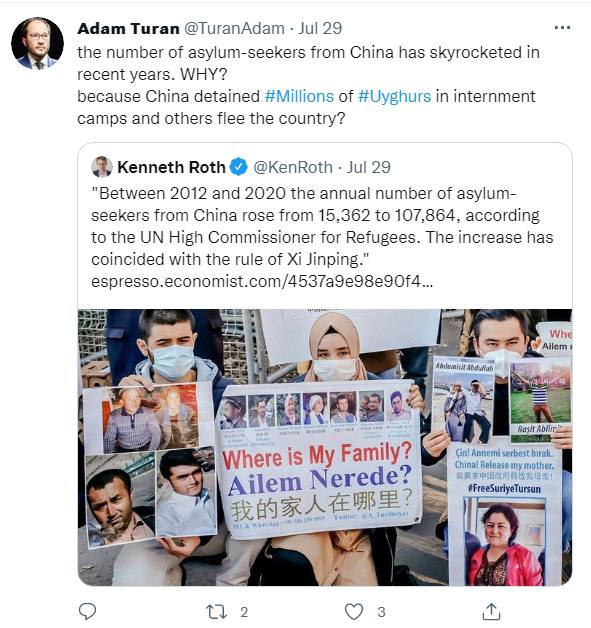
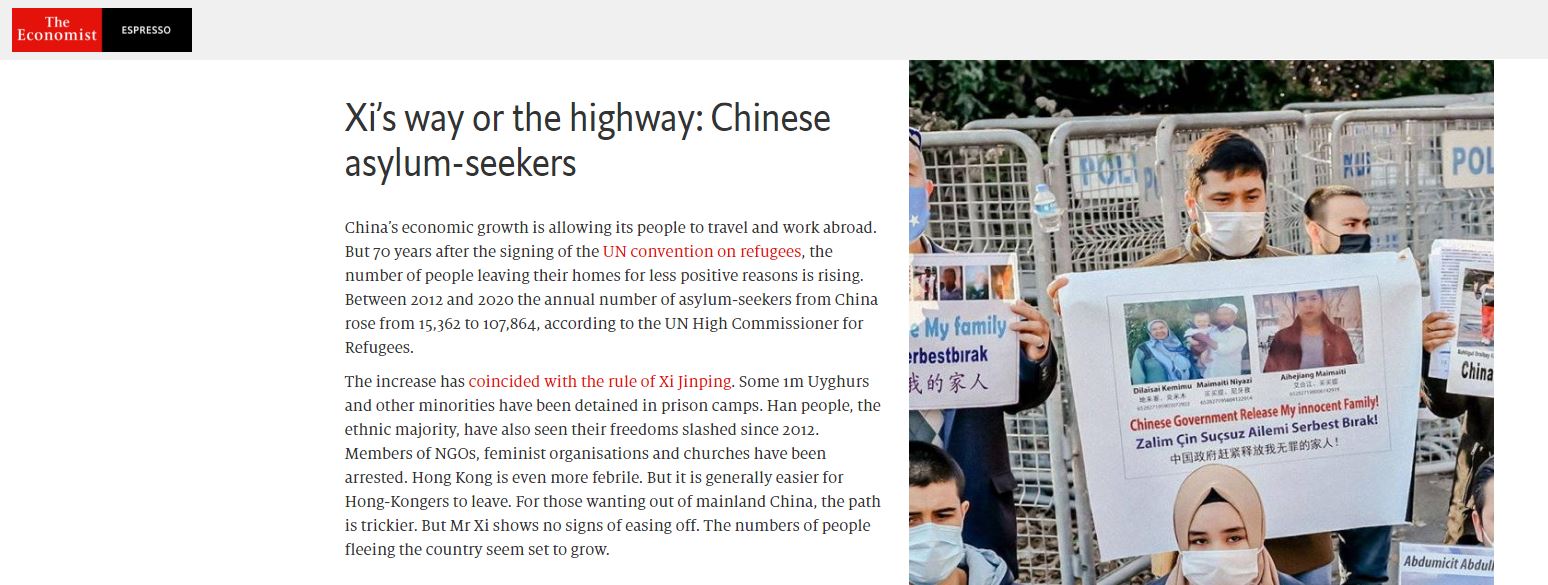
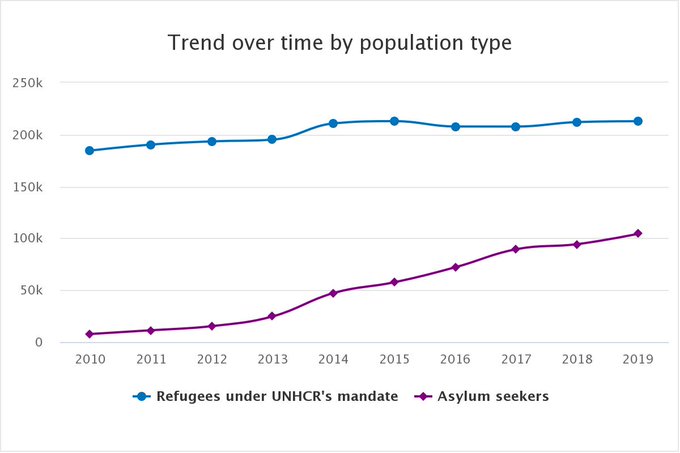

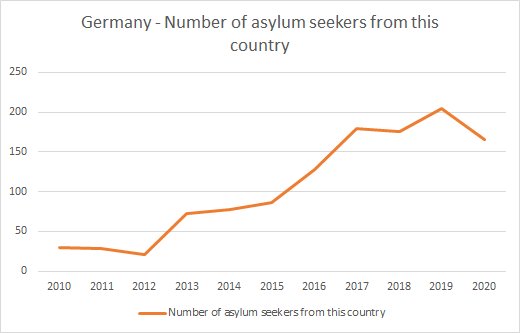
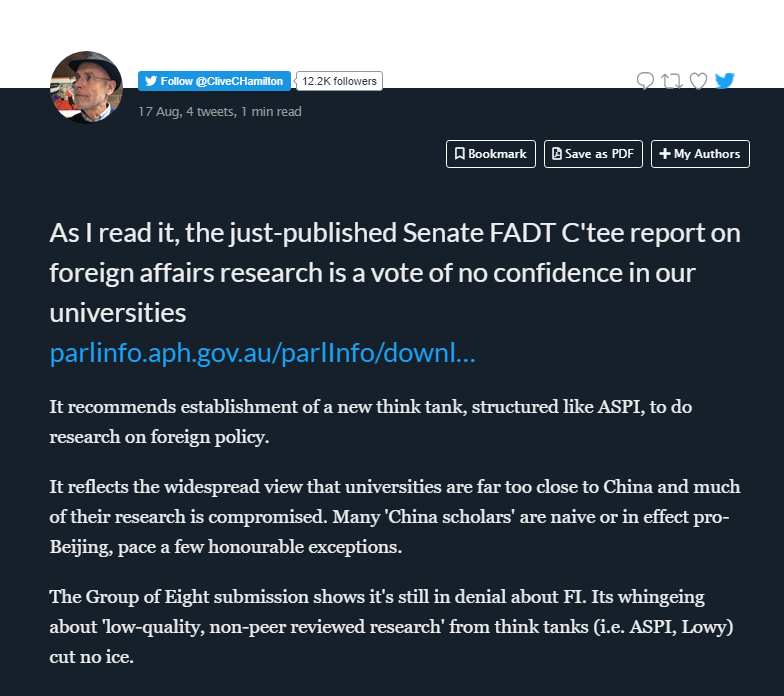 I’m sorry I can’t play that music from X-files due to copyright restrictions.
I’m sorry I can’t play that music from X-files due to copyright restrictions.
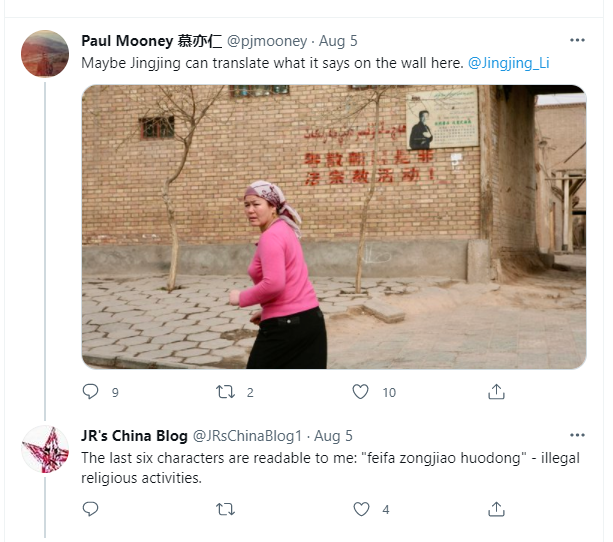
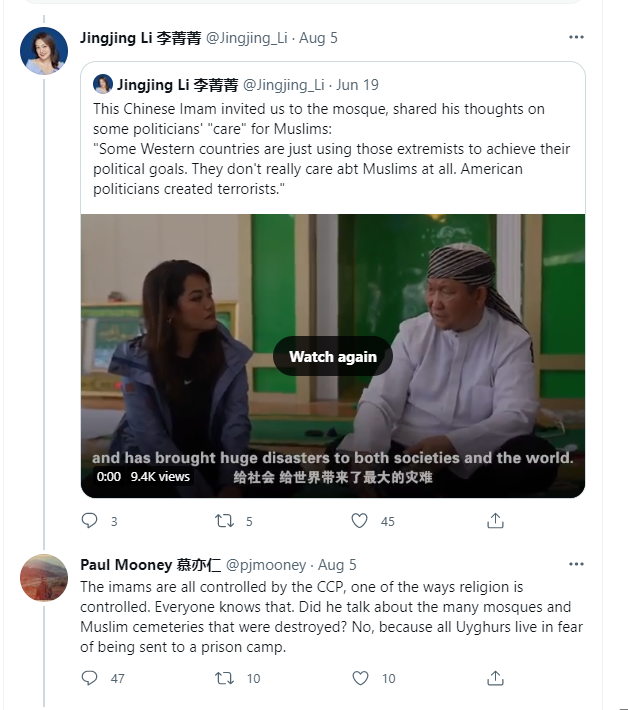
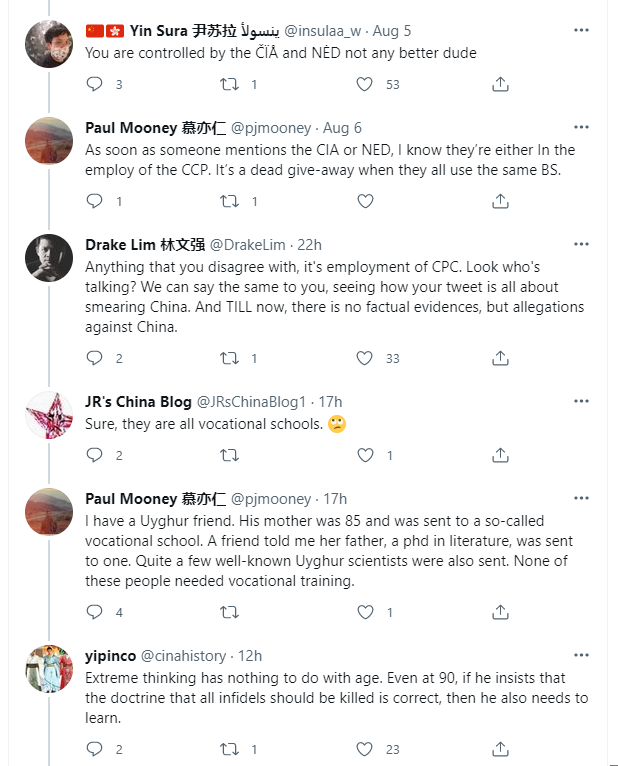
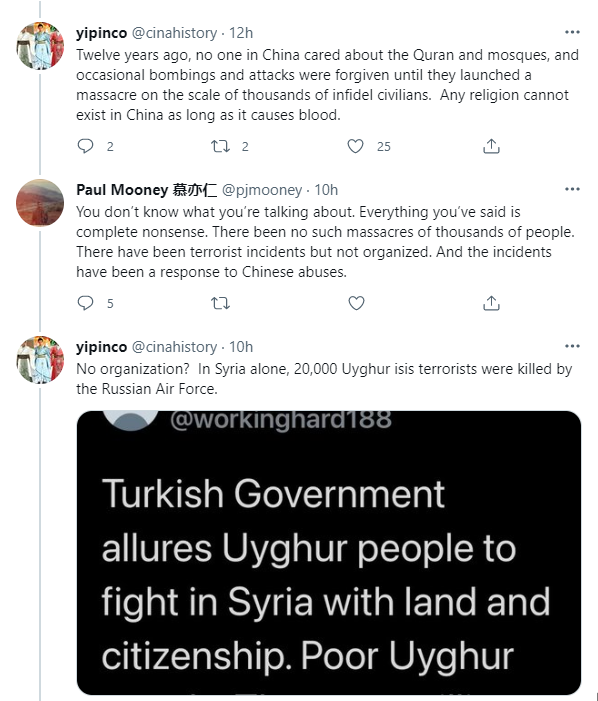 Methodically, @cinahistory takes the infants through an understanding of the history of terror. But our terror apologising CIA operative constructs his terror rationale. “The folk were pissed off. They were justified to engage in terror. If China had not been so hard on radicalisation, nothing would have happened!”
Methodically, @cinahistory takes the infants through an understanding of the history of terror. But our terror apologising CIA operative constructs his terror rationale. “The folk were pissed off. They were justified to engage in terror. If China had not been so hard on radicalisation, nothing would have happened!”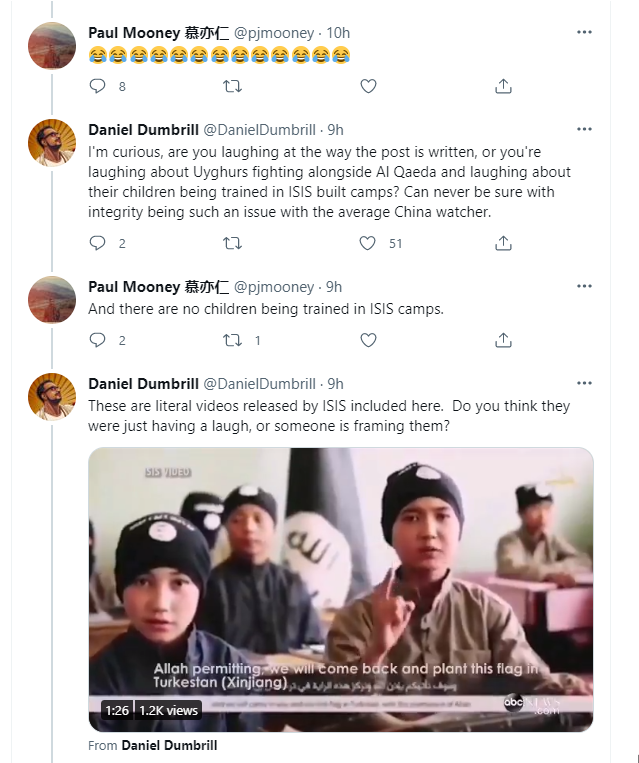 I guess Mooney’s derisive response was an open invitation for Daniel Dumbrill to bring some hard evidence to Mooney (futile as that turns out to be).
I guess Mooney’s derisive response was an open invitation for Daniel Dumbrill to bring some hard evidence to Mooney (futile as that turns out to be).